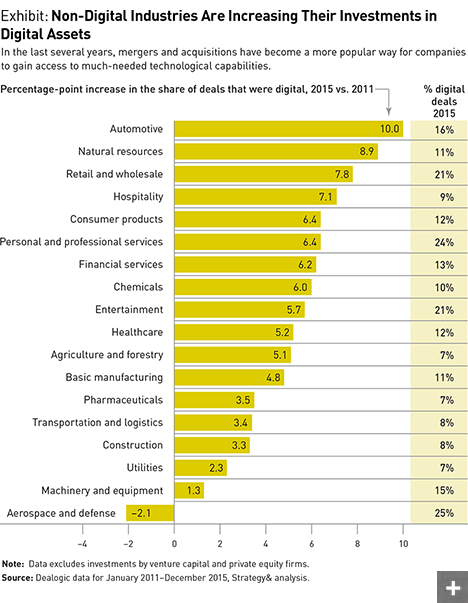Will You Be Mine in the Digital World?
As they look to enhance digital capabilities through mergers and acquisitions, traditional companies have to heed a new set of dating rules.
A version of this article appeared in the Summer 2016 issue of strategy+business.
In the space of about 17 days in the spring of 2015, Boeing bought a company that develops aerial imaging software, Spanish bank BBVA bought a design studio that specializes in the online user experience, and MasterCard purchased an analytics company that helps convenience store owners figure out what they should sell at the checkout counter.
The three deals barely registered on Wall Street. 2d3, the imaging company that Boeing bought for US$25 million, was a tiny 40-employee outfit. Spring Studio, BBVA’s acquisition, was similar — just 38 workers. Although MasterCard’s deal for Applied Predictive Technologies was larger, the $600 million purchase price (and the addition of some 300 employees to MasterCard’s payroll) had virtually no impact on the company’s share price.
Yet to dismiss these deals as inconsequential because of their limited immediate impact would be to miss the point. None of the deals was a “one and done.” The deals were among the at least seven, eight, and 10 digital acquisitions made by BBVA, MasterCard, and Boeing, respectively, since 2011. Other brick-and-mortar companies were even more active during that period. For instance, Siemens has bought or invested in at least 28 digital properties, General Electric at least 22.
In their determination not to be left behind, many traditionally non-digital companies have jumped into the market by becoming serial acquirers. The acquisitions have given these companies overnight access to software and cloud technologies that they probably wouldn’t have developed on their own. But the spate of deal making is presenting traditional companies with a new set of challenges. In the red-hot market for digital M&A — M&A in which the target is either a hardware, software, IT service, or Internet company — leaders of traditional companies must not only pick the right deals but figure out how to leverage them. Corporate development staffs and business unit managers are learning as they go.
Globally, digital deals accounted for about 32 percent of all transactions in 2015, according to a study by Strategy&, PwC’s strategy consulting business, and data provided by Dealogic. That was up from about 20 percent in 2011. The real spike has been seen in acquirers in non-digital industries, including automotive, natural resources, retail and wholesale, and hospitality (see exhibit). Companies in non-digital industries completed 48 percent more digital deals in 2015 than they did in 2011. They are embarking on multiyear efforts to protect their franchises and get ahead of their competitors.
Clear Objectives
Of the roughly 20,000 digital deals announced between 2011 and 2015, about a third involved a non-technology, non-telecom buyer, according to Strategy&’s analysis. (The total deal count excludes investments in digital properties made strictly for the purposes of getting a financial return, including investments made by venture capital and private equity firms.) These deals fit into three basic categories.
1. Acquisitions of digital products and services. Some deals are intended to give the acquirer a new product or service it can sell. The new product could be something that helps the acquirer expand its offering in an area of growing importance to customers, such as smart meters. It could be an analytics service, such as the tools for assessing patient data that 3M’s healthcare business obtained through its acquisition of Treo Solutions.
The new product could also be a digital version of a product the acquirer was previously selling in a physical form. The acquisition of Elektrobit Automotive by Continental AG in May 2015 exemplifies this. Continental had already been introducing digital products and moving beyond its roots as a maker of physical car parts — tires, brake systems, and powertrains. Elektrobit’s software for driver assistance and infotainment may allow Continental to cement its position in the digital realm.
2. New digital business models. Adding a new way of generating revenue that isn’t closely bound to the physical world is a second major objective of those pursuing digital deals. This can mean a new delivery model for a similar set of products — the goal that Walgreens had when it bought Drugstore.com in 2011. In other instances, the acquisition may allow for the possibility of entirely new service offerings; the French bank Société Générale bought Fiduceo in 2015 to get into the burgeoning area of financial account aggregation.
As consumers of information and entertainment have increasingly shifted online, media and publishing companies have been among the most avid users of M&A to recreate their business models. Since 2011, for instance, German media conglomerate Axel Springer, publisher of Bild, one of Europe’s largest-circulation newspapers, has used 25 acquisitions of digital properties to increase its presence in areas such as online classified ads and social media. The information and analytics company Relx Group (previously known as Reed Elsevier) has been equally active, buying dozens of information and software companies while disposing of some offline properties, including the print magazine Variety.
3. Digitization of the value chain. The digital acquisitions that traditional companies make aren’t always designed to sell something new. Sometimes these deals are aimed at helping companies do a better job of identifying promising new products or of speeding the delivery of products they already have or are developing.
For instance, when it bought Definiens, an identifier of biomarkers, in 2015, pharmaceutical company AstraZeneca was seeking technology that would help it identify the best patients for clinical trials of cancer drugs. BBVA was certainly thinking about its value chain in 2015 when the bank bought Madiva for its speedy mortgage-approval software. Target’s 2014 purchase of Powered Analytics was driven by a desire to give customers interactive recommendations and guidance when they were shopping in Target’s retail stores. And a steady stream of acquisitions in the Internet of Things arena, particularly of sensor and cloud technologies, is offering traditional manufacturers a way of being able to track their products in the aftermarket and play a bigger role in service and support.
To some extent, the deals in the value chain category are related to IT investments that traditional companies have been making for years, including investments in products like SAP. This makes deals in this category less experimental, in a sense, and increases the likelihood of a fast payback.
Digital Deal-Making Challenges
Many of these acquisitions thrust the acquirers into circumstances where they don’t feel as sure-footed as with other types of acquisitions. For many traditional companies, digital deals are what we call enhancement deals, since they are meant to enhance the acquirer’s existing set of capabilities. Both our experience working with buyers and research we’ve conducted show that these deals are among the trickiest to pull off (see “Deals That Win,” by J. Neely, John Jullens, and Joerg Krings, s+b, July 14, 2015).
Certainly a company would be making a colossal mistake if it tried to jam an enhancement deal through the same M&A apparatus (with an emphasis on cost synergies) that it might use for a more conventional deal. Such deals face overarching obstacles that include cultural differences and the acquiring company’s typically light experience with digital M&A. Digital M&A presents challenges at every phase of the process:
Identification. “Who do we want to buy?” With traditional deals — one company buying another in the same industry — the answer to this question is usually straightforward. The number of targets is limited by the strategic intent: to buy an adjacent product, get into a particular geographic market, or consolidate. A company’s managers may be able to generate a preliminary list based solely on their knowledge of the market, and the initial contact could easily be one executive calling another.
Very little of this framework applies to digital deals. Instead of one main person to approach, there may be four or five — a company founder, investors, key members of the team. Instead of a short set of acquisition candidates, the list may contain dozens, some of them extremely small. The acquisition ideas could come from just about anywhere — contacts at major research universities, patent searches, partners at venture capital firms. The technologies are generally new and highly specific, and their viability is often untested. In essence, traditional companies must now develop a brand-new capability in the M&A area that allows them to identify the most promising digital targets.
To deal with the complexity of the identification stage, companies must be clear about how they want to create value and how different technologies might contribute to the process. And if the buyer is making a set of acquisitions in a given area in the hope of building up a specific capability, the task gets even more complicated. The people scouring the landscape for M&A ideas must have a sense of how different technologies might interconnect and must be good judges of the feel and fit of different target companies. These situations require a new set of screening tactics.
Valuation. “What’s it worth?” In digital deal making, there is often no obvious answer to this question. There may be no cash flow to which the buyer can attach a multiple. The overheated state of the digital M&A market makes the appraisal process more difficult; with these deals, time is not on the buyer’s side.
The concept of strategic value looms large. A traditional company may have great potential in a given area but may need to chain together a few new digital capabilities to realize the opportunity. Maybe what it’s missing is a way of delivering a product digitally, or of interacting with customers through the cloud. A target company that has — or appears to have — the missing link in the capabilities chain may be able to drive a hard bargain.
As the CFO of a Fortune 500 company once said to us, you have to know your walk-away price.
And in some situations, strategic value leads to prices that simply don’t make sense for traditional companies. For instance, suppose a commercial security company sets its sights on a startup specializing in optical recognition in hopes of using the startup’s technology to create a product that would control access to buildings. At $10 million or $20 million, that might be capital well spent. But if Facebook sees the technology as something it could run across all the photos its 1.5 billion users upload and decides to enter the bidding, the contest is likely to become one the traditional company should quit. As the CFO of a Fortune 500 company once said to us, you have to know your walk-away price.
We think traditional companies largely understand this dilemma. And it helps explain why at this relatively early stage of their digital deal making, they tend to emphasize small deals over large ones. They understand the need to take a little leap of faith, but don’t want to be foolish about it.
Talent Retention. “How can we make sure the team stays?” When AstraZeneca bought biomarker company Definiens in 2015, it gained access to Gerd Binnig, a physics Nobel laureate who had founded the company. Walmart, in buying Adchemy, acquired the services of a former engineering lead at WebEx and a former head of search innovation at Yahoo.
In digital-on-digital acquisitions, these exceptionally talented scientists and technologists sometimes do stay. Nathan Myhrvold came to Microsoft after the company bought his startup for $1.5 million and played a prominent role at the software company during its dominant run in the 1980s and 1990s. Ray Ozzie, developer of Lotus Notes, likewise stayed at Microsoft for five years (2005 to 2010) as chief technical officer and chief software architect, after Microsoft bought a company he had founded.
Retention is potentially more difficult in deals where the buyer is a traditional company. But traditional companies can improve their chances at retention — and the commitment of the technologists working for them after deals close — if they go beyond money and try to identify goals the technologists can best accomplish with the help of their new, bigger organization. Money means a lot to the people who have founded a company and are selling it. But it isn’t everything, and earn-out clauses have their limits in terms of influencing behaviors.
Deal integration. “How will we integrate this company into our larger operation?” Traditional deals are often driven by the prospect of cost synergies. But since digital deals don’t naturally lend themselves to cost rationalization, acquirers need to tread lightly.
To start with, it sometimes makes sense to let the acquired company stay in its geographic location, and to limit any attempts at operational efficiencies, at least initially, to back-office integration. Acquirers must also respect cultural differences. Pushing change in a seemingly minor area such as dress codes or discontinuing a free food or beverage benefit may have a subtly crushing effect on morale. Yet an acquirer also needs to be sensitive to the impact on the broader organization if it allows an acquired unit to continue to operate by its own, more flexible or more generous rules.
In short, integrating even a small digital property requires a considerable amount of thoughtfulness on the part of a traditional company. And it isn’t only the managers or executives doing the deal who must be committed to the deal’s success. The challenges of traditional-on-digital M&A are such that before an offer is ever made, other professionals at the acquiring company, including human resources, information technology, and line managers, must buy into the post-deal integration plan, support it, and contribute to it.
Advocating for a light touch is not the same as suggesting that traditional companies should not ask their digital acquisitions to make any adjustments at all. In conjunction with the new company’s management team, the buying company (usually through an executive acting as a sponsor) needs to set milestones for product development, talent retention, and broader company collaboration. Avoiding such challenges, and instead allowing the operation to be ring-fenced, runs the risk of forestalling a linkage to the company’s broader strategy. The question is how to get the linkage. Multiple post-deal operating models exist, and companies have to select the ones that work for them on the basis of their own identity and the unique circumstances of the acquired asset.
Motivated Sellers
We’ve resisted putting it so bluntly up to now, but when digital and traditional companies enter a relationship, things can get messy. We are reminded of the problems that arose when one of the U.S.’s biggest consumer packaged goods (CPG) companies started to advertise on Google. The company’s structure was complex and the number of employees it had interacting with Google at one point would have come close to filling a Broadway theater. Neither Google nor the CPG company was happy with the results.
Applying this experience to M&A, big traditional companies should maintain some degree of centralized oversight of their digital deal-making process. Not all of them do. Given the organizational complexity of traditional companies, it would not be unusual if employees from separate functions were off trying to buy largely similar digital companies at the same time. The process works better when a single person or group oversees all the company’s digital deals and figures out how a given deal might benefit other parts of the enterprise. Without such centralized oversight, companies will miss opportunities — opportunities to learn, share ideas, preserve capital, and take advantage of new technology.
A final point: Even when they are acquiring, traditional companies have to do a sales job. They have to convince the digital company to accept their offer instead of a competitive offer from a rival suitor. To succeed, they will need as much empathy as they do cash. The offer can’t just be a certain amount of money, “take it or leave it.” Executives at traditional companies must place themselves in the shoes of the target company’s key decision makers and figure out what, on top of the payout, might matter to them. The key factor might be the chance to vastly increase the distribution of the digital company’s product. It might be the stature of being associated with a prominent brand. It might be the traditional company’s reputation for taking the long-term view. These acquisition offers are akin to a marriage proposal. When you say, “I’m the one for you,” and ask your partner to commit to you for life, it has to ring true.
Reprint No. 16207
Author profiles:
- Joerg Krings is an advisor to executives in the automotive and industrials sectors for Strategy&, PwC's strategy consulting group. He is a partner with PwC Germany based in Munich. His focus is organic and M&A growth strategies.
- J. Neely is a leading practitioner in M&A transformation with Strategy&. He is a principal with PwC US based in Cleveland. His specialty is mergers and restructurings in consumer products and industrial sectors.
- Olaf Acker is a leading practitioner in digital services and technology strategy for Strategy&. He is a partner with PwC Germany based in Frankfurt. His focus is technology and digital transformation.
- Also contributing to this article was writer Robert Hertzberg.






